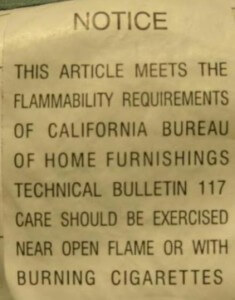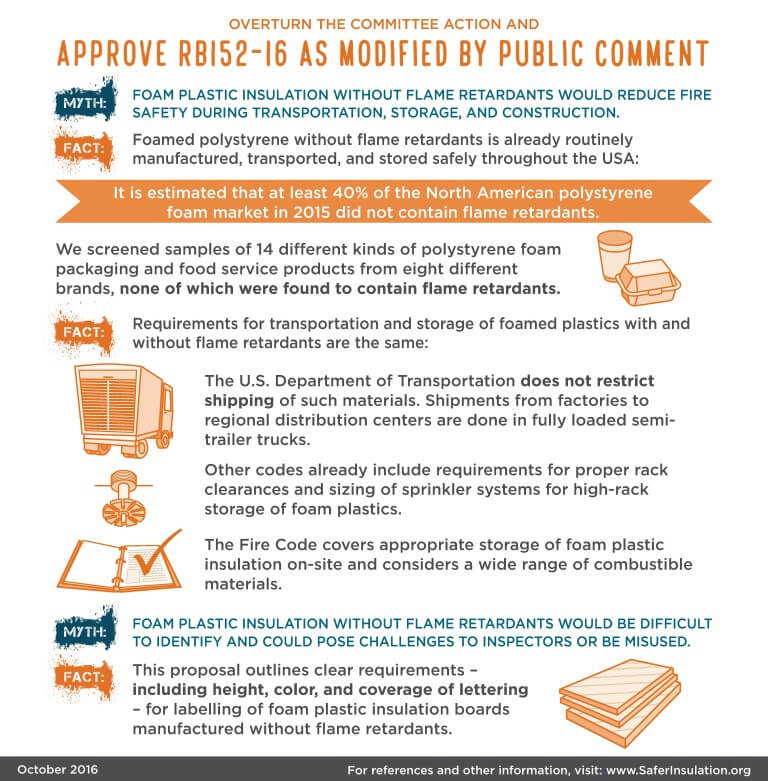November 2016: Fall Back: To a Healthier Home
In this edition:
- $340 Billion in Health Problems Estimated from Toxic Chemicals
- Do you have flame retardants in your couch?
- Who should pay for couch disposal?
- Home Free of Toxics
- Six Inches Under
- Stain-resistant seals?
Might your couch still contain toxic flame retardants? Staying with friends in a Colorado mountain town, I was surprised to find myself sitting on a couch with a TB117 label, which meant we were all still being exposed to these harmful chemicals. My friends were eager for advice on what they could do for a healthier home with less flame retardants and I thought you might be too.
The great news is that furniture standards were updated two years ago so flame retardants are no longer needed, and you can now go to a foam shop and swap out the cushion foam in your couch for flame retardant free foam. Or you can purchase a new couch as described below.
Other ways to reduce exposure to dust containing flame retardants and health harm are frequent vacuuming and handwashing.

If you decide to swap out your couch or the foam inside, another question is where it should go. We are working on a strategy for responsible disposal of furniture foam with flame retardants. Our efforts received a boost last month when the North American Hazardous Materials Management Association (NAHMMA), a society of professionals working to reduce and manage household hazardous waste, invited me to keynote their annual meeting. This community embraced our Six Classes approach to toxic chemical reduction with enthusiasm. They agree with us that if toxic chemicals aren’t put into products in the first place, this solves the disposal problem at the end of the useful life of a product.
To learn about our Six Classes approach, watch the video above.
Please read below to learn about other recent activities at our Institute and of course be sure to REMEMBER TO VOTE next week – for the health of our population and planet.
Happy Autumn,
Arlene and the Green Science Policy team
$340 Billion in Health Problems Estimated from Toxic Chemicals

A new scientific paper reports that health problems from “endocrine disrupting chemicals” are costing the U.S. an estimated $340 billion a year. In the EU, the cost estimate was $217 billion.
These chemicals are found in many consumer products and building materials and exposure has been linked to cancer, neurological and reproductive impairments, infertility, and obesity. The authors estimate that health costs could account for more than 2% of our gross domestic product.
The largest cause of harm in the US–estimated by the authors to be $209 billion–is the use of a flame retardant called pentaBDE in most furniture manufactured between 1975 and 2005. This is yet another good reason to consider replacing the foam in your old coach or buying a new one. You can learn more in a CNN article.
Do you have flame retardants in your couch?

For those of you who are still sitting on toxic couches with TB117 labels
because you are new to our e-newsletters or haven’t yet gotten around to dealing with the problem, here’s how to determine i
f your couch is likely to contain these harmful chemicals. The bottom line is foam in furniture cushions with the label on the right likely is about 5% by weight flame retardant chemical. You can check out our blog to learn more. To find out for sure if there are flame retardants in your couch, you can send a small sample of foam to Duke University for a free analysis here.
What can you do?
As it turns out, most or all of the flame retarded foam is in furniture cushions, so by swapping them out, you can have a healthier couch. (Polyester, which is less costly, is often used on the arms and backs of furniture and does not contain flame retardants.)
Eileen, in her blog, shares her happy story of swapping the foam in her couch cushions for flame retardant free foam.
The other option is to buy a new couch without the chemicals. Be sure to look for the updated TB117-2013 label. It will include statements indicating whether flame retardants are used or not.
One question discussed at the North American Hazardous Materials Management Association annual conference in Portland, OR, was “who will pay” to dispose of toxic household products such as furniture with flame retardants. Safe disposal of batteries and light bulbs has received a lot of attention in recent years, but what about all the other consumer products? Should producers take more responsibility through Extended Producer Responsibility? One example is a program initiated by the Mattress Recycling Council which diverts mattresses from landfill by separating them out or through recycling drop-off locations. Of course, couches with toxic flame retardants should not be recycled and pose a greater challenge–and we are currently working on finding solutions to this problem. You can learn more at our February 8, 2017 Responsible Disposal meeting in Berkeley.
Who should pay for couch disposal?
One question discussed at the North American Hazardous Materials Management Association annual conference in Portland, OR, was “who will pay” to dispose of toxic household products such as furniture with flame retardants. Safe disposal of batteries and light bulbs has received a lot of attention in recent years, but what about all the other consumer products? Should producers take more responsibility through Extended Producer Responsibility? One example is a program initiated by the Mattress Recycling Council which diverts mattresses from landfill by separating them out or through recycling drop-off locations. Of course, couches with toxic flame retardants should not be recycled and pose a greater challenge–and we are currently working on finding solutions to this problem. You can learn more at our February 8, 2017 Responsible Disposal meeting in Berkeley.
Home Free of Toxics

Last week team members Avery and Veronica attended the Healthy Building Network‘s workshop to raise awareness of Homefree, their on-line tool that identifies healthy building materials for affordable housing. The event was held at First Community Housing‘s newly completed, LEED platinum, San Jose Japantown Senior Apartments. We were delighted to learn more about this important project by our Healthy Affordable Materials Project partner, while also getting to share about our ongoing work with this community. The cherry on top was learning that all the furniture in the event room was flame retardant free!
Six Inches Under

Taking flame retardants out of insulation used under concrete has been called a “no-brainer.” There is no oxygen, fire source or fire hazard below grade. So why can’t architects and designers specify flame retardant-free insulation?
U.S. building codes currently require foam plastic insulation to meet criteria that lead to the use of flame retardants and in many cases the chemicals are not needed to provide fire safety. We co-authored a proposal to update the 2015 International Residential Code (IRC) to enable safe, below-grade use of foam plastic insulation boards without flame retardants. While our proposal received support from an estimated 30% of voters at hearings in October, the proposal was not approved. We will continue to work towards the goal of safely reducing use of hazardous flame retardants in building insulation.
Contact [email protected] for more information.
Stain-resistant seals?

Arctic hooded seal mothers pass highly fluorinated chemicals, used to make consumer products stain and water resistant, to their pups through their milk and placenta, a new study has found. The chemicals have been linked to kidney and testicular cancer, elevated cholesterol, obesity, and immune suppression in humans.
Highly fluorinated chemicals were measured in every seal studied, and pups’ plasma levels were about twice as high as their mothers. This is concerning because like most mammals, infant seals are more vulnerable to toxics.
Greenpeace has an informative short video showing how these chemicals, which can persist in the environment for millions of years, are spreading all over the globe. Sadly, pollutants tend to build up at the highest levels in polar regions, the hooded seals’ Arctic habitat. Click here to learn more.
Receive Updates By Email
Subscribe to our monthly newsletter and get these updates delivered right to your inbox!